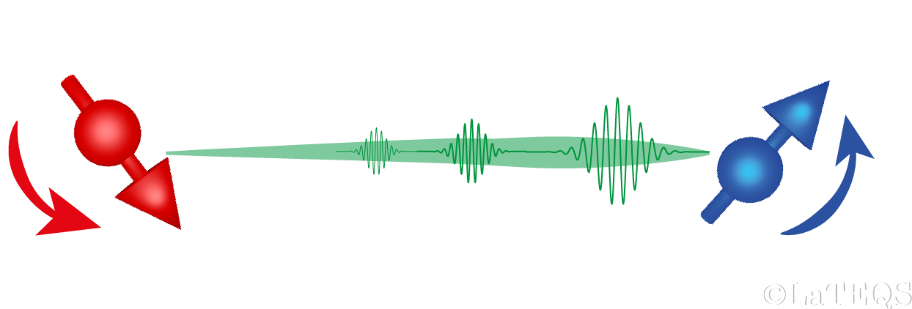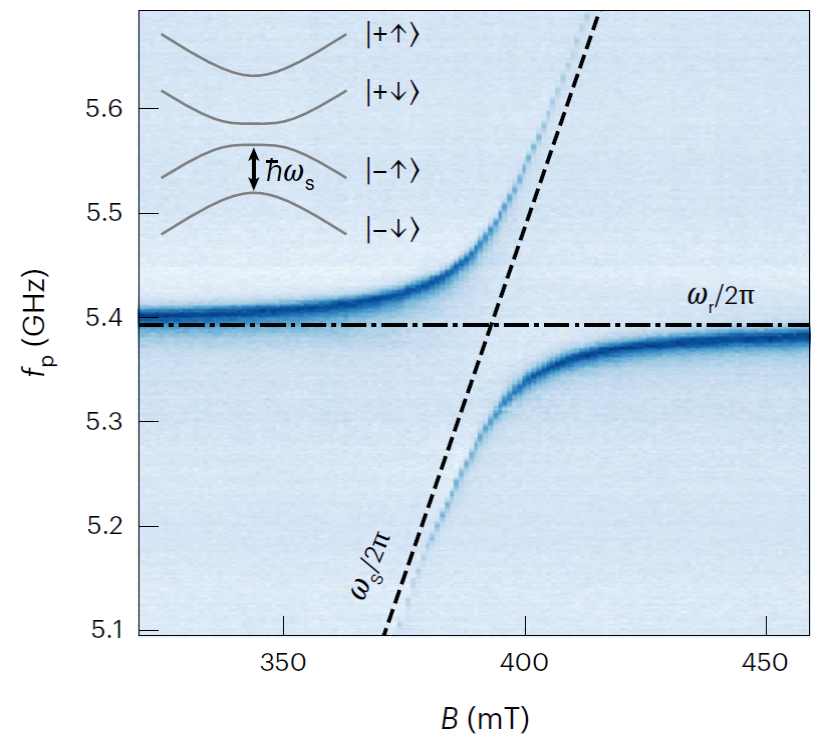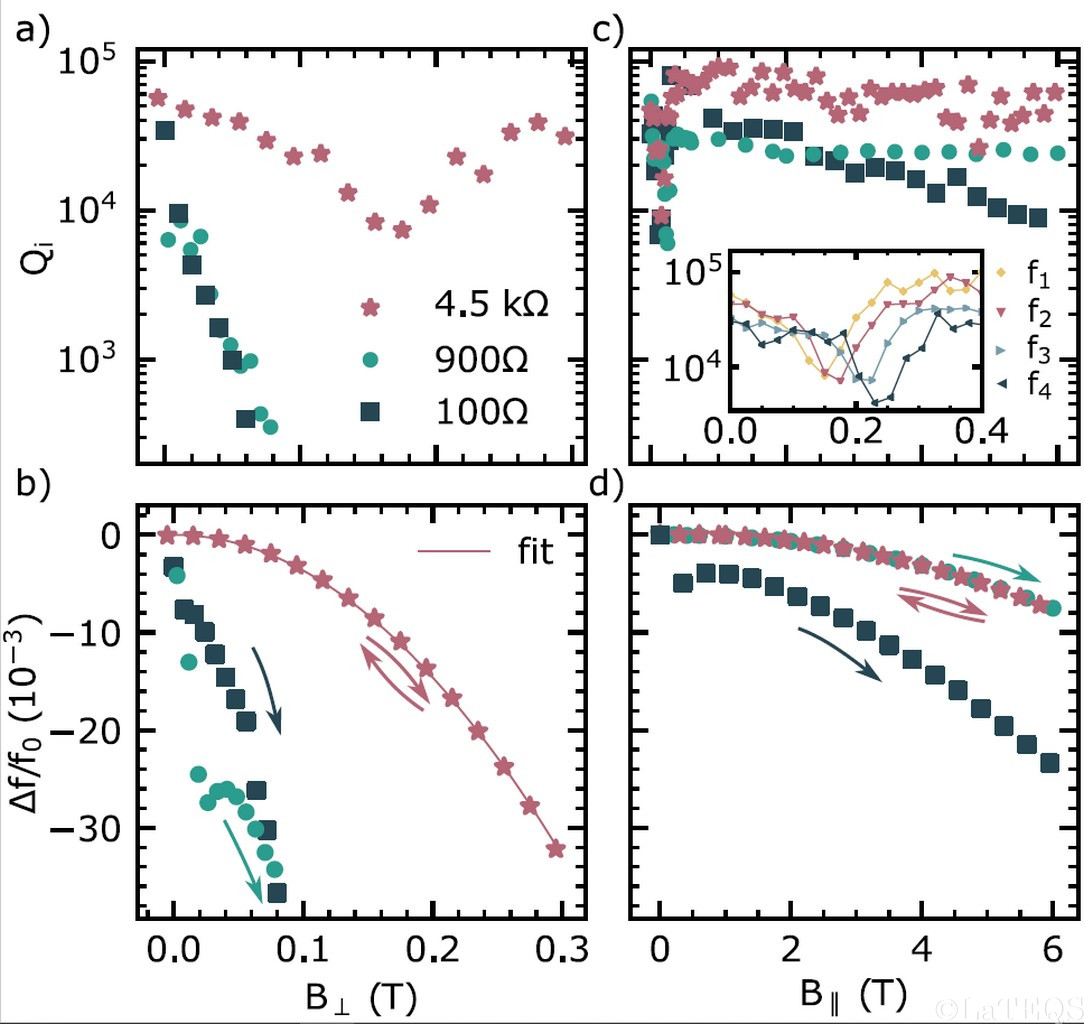While spins are excellent quantum bits, their long-range coupling remains a challenge to tackle towards complex
quantum devices for quantum computing and quantum simulation [1].
Our research proposes to take up this challenge using a microwave photon as a quantum mediator between distant qubits
in silicon or in other word open spin qubits to circuit quantum electrodynamics

Hybrid spin cQED
Practically, we take advantage of the exceptional properties of hole spin-orbit qubits in silicon,
namely their strong spin-orbit coupling, to coherently couple them to microwave photons in superconducting
cavities made from thin NbN layers [2]. Recently, we demonstrated a strong entanglement between a hole spin
and a microwave photon [3].
This crucial demonstration shows that hole spin-orbit qubits can leverage quantum electrodynamics,
which holds great promises for quantum computing, quantum simulation and the exploration of light-matter
interaction in extreme regimes [4, 5].

Figure 2 : Schematic drawing of a hole spin cQED sample, where a single hole spin (green arrow)
interacts coherently with a microwave photon in a cavity symbolized by two yellow mirrors.
(b) An avoided anticrossing – the signature of strong spin-photon coupling – is is observed when the spin transition
frequency (dashed line) matches the bare resonator frequency (dashed–dotted line).
Frequency linecut at resonance, highlighting a vacuum Rabi-mode splitting 2gs/2π=184 MHz.
Currently we are developing a novel spin-orbit cQED architecture leveraging an unprecedented combination of academic and industrial tools to realize flip-chip devices.
The key idea is to combine one chip with high-quality, high-impedance microwave circuits with a second chip hosting hole spin-orbit qubits in silicon in a flip-chip assembly (see figure below).

Figure 3 (a) Schematic overview of a flip-chip assembly, which contains hole spin qubits on the top chip and high-quality,
high-impedance microwave circuits on the bottom chip. Electrical and mechanical connections between both chips are ensured by micrometer
sized indium balls. (b) Picture of a flip-chip sample bonded to a circuit-board.
If successful, our unique flip-chip hardware will allow us to investigate novel research paths. This includes for example long-distance spin-spin entanglement
and high-fidelity spin readout on ns time scales, both essential for quantum information processing.
Another path we envision is toward analog quantum simulation of many body problems. Indeed, a microwave cavity connected to multiple spins comes naturally
with an all-to-all connectivity and hence allows for many-body entanglement and the study of spin models. Similarly, a single hole spin coherently coupled
to multiple microwave cavities realizes another prototypical many-body problem, the spin-boson model [6, 7].
The hole spin cQED architecture will hence allow to unlock the physics of many-body interacting systems, a largely unexplored field.
This project involves Romain Maurand, Simon Zihlmann, Etienne Dumur, Léo Noirot, Sébastien Granel, Karl Leuckefeld, Frederic Gustavo, and Jean-luc Thomassin.
It has received funding by the European Research council under the ERC starting grant project LONGPSIN, the French national quantum initiative (Presquile and Miracle_Q)
and the European project QLSI2.
Refs:
Scientific Publication about "CQED with spins project ":
Strong coupling between a photon and a hole spin in silicon

We demonstrate strong coupling between a microwave photon in a superconducting resonator and a hole spin in a silicon-based double quantum dot issued from a foundry-compatible metal–oxide–semiconductor fabrication process. By leveraging the strong spin–orbit interaction intrinsically present in the valence band of silicon, we achieve a spin–photon coupling rate as high as 330 MHz, largely exceeding the combined spin–photon decoherence rate. This result, together with the recently demonstrated long coherence of hole spins in silicon, opens a new realistic pathway to the development of circuit quantum electrodynamics with spins in semiconductor quantum dots.
Read more :nature.com
Magnetic field resilient high kinetic inductance superconducting niobium nitride coplanar waveguide resonators

High quality superconducting microwave resonators are at the heart of circuit quantum electrodynamics experiments.
Here, we report on simple to fabricate coplanar waveguide resonators fabricated from a thin film of NbN.
Using the large kinetic inductance of NbN, we achieve characteristic impedances of up to 4 kOhm. These large impedances,
paired with the excellent magnetic field resilience (see figure), makes these resonators perfectly suited for cQED experiments
requiring magnetic fields such as spin qubits.
Read more in Yu et al. APL 118 054001 (2021)
